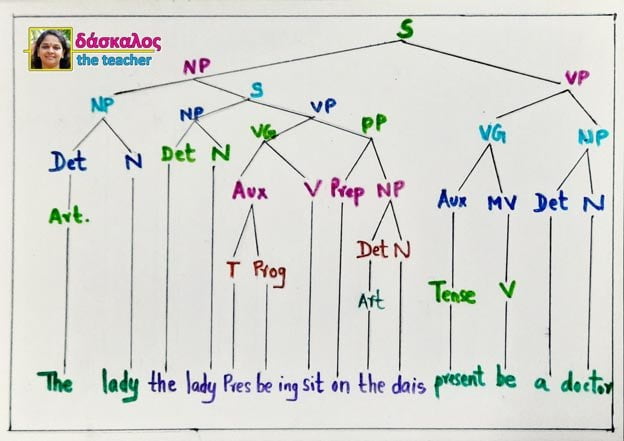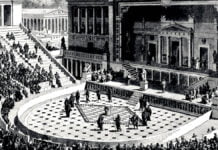In transformational grammar, relativization is the process of forming sentences with relative clauses in them. Relativization as a syntactic process, like complementation and coordination exhibit the recursiveness of language since a symbol can be expanded into a string in which that symbol recurs.
S -> NP + VP
NP -> NP + S
In English, a relative clause is embedded within a noun phrase and it functions as a postnominal modifier.
- The lady who is sitting on the dais is a doctor.
- The boy whom you met in the library is my cousin.
- The showcase which John bought yesterday is quite costly.
In the sentences given above, the italicized relative clauses are embedded within their antecedent noun phrases and they function as the postnominal modifiers (of those noun phrases). The relative clauses functioning as postnominal modifiers are understood as full-fledged sentences at the deep structure level and phrase-structure rules are applied to generate them.
The three common strategies for forming relative clauses in English are (1) relative pronouns, (2) the subordinator (or relativizer) that, and (3) gapping and repeated structure deletion.
A relative clause is generally introduced by a relative pronoun-‘who’, ‘whom’, ‘which’, or ‘that’, or by the relative pronominal modifier-‘whose’, or by a relative adverb-‘where’, ‘when’, ‘why’, or ‘how’. ‘Who’, ‘whom’, ‘which’, and ‘that’ are relative pronouns because they are complete substitutes of the NPs in the relative clause and are equivalent to the antecedent NPs that the relative clauses modify.
Now, the PSRs applied for the relative clause and its antecedent NP in sentence 1 are as follows :
NP -> {Det + N} ; {NP + S}
Det -> Art
Art -> the
N -> lady, dais
S -> NP + VP
VP -> VG PP
VG -> AuxV
Aux -> Tense + Prog
Tense -> Present
Prog -> be + ing
V-> sit
Prep Phr -> Prep + NP
Prep -> on
The meaning can be captured in the tree diagram as:

Thus the generalised phrase marker is: The lady (the lady pres- be-ing-sit on the dais)
The transformational rules (TRs) are applied to the generalized phrase marker to generate the surface structure.
Matrix S: The lady is a doctor.
Insert S: The lady is sitting on the dais.
DS: The lady [the lady pres- be-ing-sit on the dias] pres- be a doctor.
RPS -> The lady [who- pres- be- ing- sit on the dias] pres- be a doctor.
AS -> The lady who- be- present-sit -ing- on the dais – be- present- a doctor.
SS: The lady who is sitting on the dais is a doctor.
Sample RC Transformation
(a) Relative Pronoun Substitution
Matrix S: The boy ran away.
Insert S: The boy knew the truth.
DS: The boy [the boy past-know the truth] past-run away.
RPS -> The boy [who past – know the truth] past – run away.
AS -> The boy who know – past the truth run – past away.
SS: The boy who knew the truth ran away.
(b) Relative Pronoun (RP) Fronting and RP Deletion
This is the book I told you about.
Matrix S: This is the book.
Insert S: I told you about the book.
DS: This pres – be the book [I past – tell you about the book]
RPS -> This pres – be the book [I past – tell you about which]
RP Fronting -> This pres – be the book [which I past – tell you about]
RP Deletion -> This pres – be the book I past – tell you about.
AS -> This be – pres the book I tell – past you about.
SS: This is the book I told you about.
(c) RP + Be Deletion
The man digging in the garden is my brother.
Matrix S: The man is my brother.
Insert S: The man is digging in the garden.
DS: The man [The man pres-be-ing-dig in the garden] pres-be my brother.
RPS -> The man [who pres-be-ing-dig in the garden] pres-be my brother.
RP+Be Del -> The man [-ing-dig in the garden] pres-be my brother.
AS -> The man [dig -ing in the garden] be-pres my brother.
SS: The man digging in the garden is my brother.
(d) Adjective Shift
The old man died.
Matrix S: The man died.
Insert S: The man was old.
DS: The man – [The man past-be old] – past – die.
RPS -> The man [who past-be-old]- past-die.
RP+Be Del -> The man-[old]-past-die.
Adj Shift -> The old man past-die.
AS -> The old man die-past.
SS: The old man died.
The adjective within the brackets is shifted to the attributive position before the main NP.






























